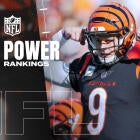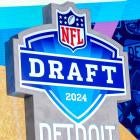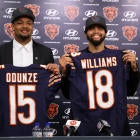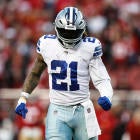Odell Beckham, Jr. is officially in the on-deck circle. Giants President and CEO John Mara announced late last week that negotiations for a new contract would start "sooner rather than later." His feelings towards Beckham have taken a sharp turn since the annual NFL owners' meeting in late March. Mara publicly vented his frustration with Beckham's behavior while also declaring the mercurial wide receiver wasn't untouchable, which prompted speculation that he could be traded.
Beckham has been on his best behavior ever since. He had near perfect attendance at New York's offseason workouts. Unlike fellow 2014 first round picks, Rams interior defensive lineman Aaron Donald and Raiders defensive end Khalil Mack, Beckham isn't holding out of training camp as a gesture of good faith despite a long held desire for a new contract. Beckham isn't showing any ill effects from the broken ankle that cost him the final 12 games of the 2017 season. He has been spectacular in practices.
Beckham's performance and impact
Beckham arguably had the best first three seasons for a wide receiver in NFL history. He had 288 receptions (tied for first), 4,112 receiving yards (second) and 35 touchdown catches (tied for fifth) in 43 games. Jerry Rice and Randy Moss are the only wide receivers with comparable production. Beckham is still in the top 10 through four seasons in these categories despite missing 17 out 64 games. He is also the only player to ever have at least 90 catches and 10 touchdown receptions in each of his first three seasons. The supremely talented Beckham can be included in the discussion about the NFL's best wide receiver with Antonio Brown and Julio Jones.
Beckham is the driving force behind the Giants' offense. Prior to last season, the Giants averaged 23 points per game when Beckham played. In the 12 games he missed in 2017, 13.9 points per game were averaged.
Beckham has also been the key to quarterback Eli Manning's success over the last four years. Manning has a 63.6 completion percentage, 91.5 passer rating, with 66 touchdowns and 29 interceptions while Beckham has been on the field. With Beckham sidelined, Manning's completion percentage and pass rating drop to 60.4 and 75.0. He has 14 touchdowns and 14 interceptions.
Desperately wish you had a 30-minutes-or-so, daily NFL podcast in your podcast app every morning by 6 a.m.? Put some Pick Six Podcast in your life and join Will Brinson as he breaks down the latest news and notes from around the league, as well as the win totals on a team-by-team schedule. It's a daily dose of football to get you right for that commute or gym trip. Subscribe: via iTunes | via Stitcher | via TuneIn | via Google Play
Current NFL wide receiver market and salary benchmarks
Beckham, who is scheduled to play 2018 on his $8.459 million option year salary, has clearly outperformed his contract. The market is well-defined after most of the wide receivers taken in the first two rounds of the 2014 NFL Draft signing new contracts since the end of last season.
The most surprising deal belongs to Sammy Watkins. He received a three-year, $48 million contract with $30 million fully guaranteed from the Chiefs in free agency although he has yet to live up to the potential that led to him being 2014's fourth overall pick. Watkins caught a rather pedestrian 39 passes for 593 yards and eight touchdowns with the Rams last season after being traded from the Bills during training camp. His only 1,000 receiving yard season came in 2015. Prior to the trade, the Bills passed on a fifth-year option in 2018 for Watkins at $13.258 million due to persistent problems with a broken left foot.
Jarvis Landry, who was designated as a franchise player by the Dolphins at $15.982 million before the Browns traded for him in March, fundamentally changed the way slot wide receivers are paid. Cleveland signed Beckham's former LSU teammate to a five-year, $75.5 million deal with $47 million in guarantees. $34 million was fully guaranteed at signing. Wide receivers that primarily thrive in the slot, like Landry has, typically have been paid less than those that excel on the outside or can take the top off opposing defenses.
The Buccaneers gave 2014 seventh overall pick Mike Evans a five-year extension averaging $16.5 million per year with $55.008 million in guarantees in March before free agency started where $38.258 million is fully guaranteed. In 2017, Evans joined A.J. Green and Moss as the only wide receivers in NFL history to reach the 1,000 receiving yard mark in each of their first four seasons.
More recently, 2014 20th overall pick Brandin Cooks received a five-year, $81 million extension (worth up to $84.5 million through salary escalators) with $50.459 million in guarantees from the Rams, who acquired him from the Patriots in an April trade, as the start of training camp was approaching. He has had three straight 1,000 receiving yards seasons.
The riches are even extending to the 2015 draft class. The Vikings just signed Stefon Diggs, to a five-year, $72 million extension ($81 million maximum with salary escalators). Diggs, who has yet to hit 1,000 yards receiving in a season, has $40.007 million in guarantees.
Any deal Beckham signs should, at a minimum, set new standards in most major contract metrics. The current NFL wide receiver salary standards in key contract metrics are listed below.
Average yearly salary: $17 million (Antonio Brown, Steelers)
Overall contract guarantees: $55.008 million (Mike Evans, Buccaneers)
Fully guaranteed at signing: $38.258 million (Evans, Buccaneers)
Fully guaranteed within 12 months: $49 million (DeAndre Hopkins, Texans)
Three-year cash flow: $55.008 million (Evans, Buccaneers)
First three New Years: $55.5 million (Brown, Steelers)
Professionals within the industry (agents and team negotiators) typically value deals by new money, which is the amount of compensation in a contact excluding what a player was scheduled to make before receiving a new deal. For example, Evans had one year left on his contract at $13.258 million when he received his new deal in March. Although he signed a six-year contract for $95.758 million, it's considered as a five-year, $82.5 million extension with a new money average of $16.5 million per year among industry professionals. Evans' remaining contract year is subtracted from the $95.758 million six-year total to arrive at this number.
Average yearly salary is the most popular contract measure with the general public and is an accepted method to determine the highest paid player at the various positions and league wide. The lack of security in NFL contracts diminishes the metric's usefulness.
Compensation in the first three years of a deal and the money in the first three new years of a contract are more important measures when assessing contracts. The new years approach focuses on the amount of money in a contract exclusive of what a player was scheduled to make before receiving a new deal, just like with new money when determining average yearly salary. The cash flow analysis looks at the compensation in its totality. The focus is on the amount of money received in the first three years of a contract regardless of whether it's considered as new money. Both metrics have the same dollar amount when a player signs a new contract as a free agent or when his contract is set to expire.
Overall contract guarantees can be misleading. A complete picture of a contract's true security isn't given by this metric. The amount of money fully guaranteed at signing and will become fully guaranteed early in the contract are the best and most accurate measures of security.
WR market stagnation
Beckham reportedly wants $20 million per year. The demand, if accurate, isn't unreasonable in light of the contracts inferior wide receivers have been getting. For example, Watkins is being paid like an elite wide receiver without ever having matching production.
The bigger issue for Beckham is the wide receiver market remaining stagnant under the current Collective Bargaining Agreement. The lack of growth with the highest paid wide receiver since the CBA was implemented in 2011 is highlighted in the following chart:
| Year | Highest-paid WR | Team | Avg. salary |
|---|---|---|---|
2011 | $16,142,857 | ||
2012 | $16,207,143 | ||
2013 | Calvin Johnson | Lions | $16,207,143 |
2014 | Calvin Johnson | Lions | $16,207,143 |
2015 | Calvin Johnson | Lions | $16,207,143 |
2016 | A.J. Green | $15,000,000 | |
2017 | Antonio Brown | $17,000,000 | |
2018 | Antonio Brown | Steelers | $17,000,000 |
The top wide receiver contracts have failed to keep up with the growth in the salary cap. When Fitzgerald signed his contract, the salary cap was $120.375 million. It is currently $177.2 million, which is a 47.2 percent increase. The highest paid wide receiver's contract in 2018 averages 5.1 percent more than in 2011.
Adjusting the top deals by the growth in the salary cap since their signing puts Fitzgerald and Johnson at significantly more than $20 million per year. The chart below outlines their adjusted contracts:
| Team | Year signed | Growth factor | Guaranteed money | New money avg. | Adjusted guaranteed money | Adjusted new money avg. | Contract length | |
|---|---|---|---|---|---|---|---|---|
Calvin Johnson | Lions | 2012 | 46.93% | $53,250,000 | $16,207,143 | $78,241,294 | $23,813,480 | 7-year extension |
Larry Fitzgerald | Cardinals | 2011 | 47.21% | $45,000,000 | $16,142,857 | $66,242,991 | $23,763,359 | 7-year extension |
A $20 million per year deal would make Beckham the NFL's highest paid non-quarterback. It wouldn't be unprecedented for a wide receiver. Fitzgerald and Johnson have both held the distinction in recent years. If an agreement at this level is reached quickly, Beckham would only temporarily lead non-quarterback compensation. The Rams are reportedly offering Donald a deal in excess of this mark.
A $20 million per year deal would be a major reset for the wide receiver market. It would raise the bar by 17.65 percent over Brown's extension. The increase would pale in comparison to what Todd Gurley did for what had been a declining running back market with the four-year, $57.5 million extension (worth a maximum of $60 million through realistically achievable salary escalators) he received from the Rams last week. Gurley's deal is almost a 75 percent increase over the previous running back benchmark.
The franchise tag game, if Beckham plays out his rookie contract, can also be used as ammunition for his reported asking price. Beckham getting an exclusive franchise tag in 2019 can't be ruled out considering running back Le'Veon Bell is playing on one for the second straight year.
Preliminarily, the 2019 exclusive wide receiver number projects to $19.801 million. The figure would be the average of the top five 2019 wide receiver salaries (typically salary cap numbers) when next year's restricted free agent signing period ends on April 19. A second franchise tag in 2020 at a 20 percent increase over Beckham's 2019 franchise number would be slightly over $23.75 million. The average of franchising Beckham twice in this manner would be a little more than $21.75 million per year.
What Beckham's contract could look like
A deal making Beckham a charter member of the $20 million per year non-quarterback club could be structured in the following manner.
Average per year: $20 million
Overall guarantees: $64.459 million
Fully guaranteed: $47 million
Three-year cash flow: $64.459 million
First three New Years: $66 million
Contract length: Five-year Extension
These numbers are based on the most player friendly, lucrative wide receiver contracts. Beckham's percentage of money in each of these metrics is consistent with Evans, Hopkins and Jones' respective percentages.
The Giants challenging salary cap situation shouldn't be an impediment to a new contract. There's a league low slightly less than $1 million of salary cap room available to the Giants. Beckham's deal can free up cap space. Lowering Beckham's $8.459 million 2018 salary to $859,000, which is slightly above his $790,000 league minimum salary, while giving him a $25 million signing bonus would create $2.6 million of cap room.
Ideally, Beckham would only have three new contract years added so his deal would expire after the 2021 season when he is 29 year old. He would be preventing a potential Julio Jones situation where he might feel his contract has become outdated over time. Unhappiness over changes in the market since signing a deal in 2015 that made Jones the NFL's second highest paid wide receiver prompted him to boycott all of the Falcons' offseason activities. The Falcons agreed to minor contract adjustment where Jones gets a $2.9 million raise by taking money from his 2019 base salary to ensure that he reported to training camp on time.
Unfortunately for Beckham, the most frequent length for first round picks signing extensions in a contract year under the current CBA's rookie wage scale is five years. There have been 26 contract year extensions with 2011 through 2014 first round picks. 16 (or 61.5 percent) have been five-year extensions. Wide receivers have gotten five of the 26 extensions. Green (Bengals) is the only one who didn't sign a five-year extension. His is four years.
Team salary hierarchy
Becoming the highest paid player could be a challenge for Beckham. Eli Manning has that honor at $21 million per year. The four-year, $84 million extension Manning signed in 2015 had a then NFL record $65 million in overall contract guarantees. The 37 year old Manning's contract runs through the 2019 season.
Typically, the starting quarterback is at the top of a team's salary hierarchy when he gets a lucrative contract. Ryan Tannehill became the highest paid player on the Dolphins (by average yearly salary) in 2015 despite signing Ndamukong Suh, who was one of the game's best defensive players, to a contract in free agency making him the NFL's highest paid non-quarterback. The Chiefs kept Justin Houston's average right under Alex Smith's $17 million per year. Houston was coming off a 2014 season in which he almost broke Michael Strahan's NFL single season record of 22.5 sacks by posting an NFL leading 22 sacks when he signed a six-year contract as a franchise player averaging $16,833,333 per year in 2015.
Ben Roethlisberger signed a four-year extension with the Steelers in 2015 for $21.85 million per year. His deal averages almost 30 percent more than Brown's. This is despite Brown easily being the NFL's most productive pass catcher over the last five seasons. Brown leads the NFL in receptions (582), receiving yards (7,848) and touchdown catches (52) since the start of the 2013 season.
Final thoughts
Beckham should have a new contract in place before the Giants' regular season opener against the Jaguars on September 9 since the parties seem to be motivated to reach an agreement. Manning didn't get his deal in 2015 until a day before the first game. Beckham and the Giants should probably be judicious with his workload during camp and the preseason to make sure he is healthy for the start of the season, unlike last year.
Any offer that doesn't reach $18 million per year with at least $55 million in guarantees where a minimum of $40 million is fully guaranteed at signing ought to be rejected. A contract at this baseline level shouldn't be the customary five-year extension first round picks in contract years are signing. If so, more substantial salary escalators than in Cooks and Diggs' deals would be a necessity.





















